A New Reconfigurable Agricultural Vehicle Controlled by a User Graphical Interface: Mechanical and Electronic Aspects
Abstract
1. Introduction
2. Materials and Methods
2.1. Reconfigurable Grape-Transporting Vehicle
2.1.1. Environment and Relative Constraints
2.1.2. Running Gear’s Size and Traction Motors
2.1.3. Mechanical Design
3. Results
3.1. Mechanical Final Design
3.2. Electronic System Final Design
3.3. System Architecture and User Interface
4. Discussion
Author Contributions
Funding
Data Availability Statement
Acknowledgments
Conflicts of Interest
References
- Bechar, A.; Vigneault, C. Agricultural robots for field operations: Concepts and components. Biosyst. Eng. 2016, 149, 94–111. [Google Scholar] [CrossRef]
- Su, L.; Liu, R.; Liu, K.; Li, K.; Liu, L.; Shi, Y. Greenhouse Tomato Picking Robot Chassis. Agriculture 2023, 13, 532. [Google Scholar] [CrossRef]
- Yu, X.; Fan, Z.; Wang, X.; Wan, H.; Wang, P.; Zeng, X. A lab-customized autonomous humanoid apple harvesting robot. Comput. Electr. Eng. 2021, 96, 107459. [Google Scholar] [CrossRef]
- Zhou, C.; Jun, H.; Xu, Z.; Yue, J.; Ye, H.; Yamg, G. A Novel Greenhouse-Based System for the Detection and Plumpness Assessment of Strawberry Using an Improved Deep Learning Technique. Front. Plant Sci. 2020, 11, 559. [Google Scholar] [CrossRef] [PubMed]
- Visconti, P.; de Fazio, R.; Primiceri, P.; Cafagna, D.; Strazzella, S.; Giannoccaro, N.I. A solar-powered fertigation system based on low-cost wireless sensor network remotely controlled by farmer for irrigation cycles and crops growth optimization. Int. J. Electr. Telecom. 2020, 66, 59–68. [Google Scholar]
- Keller, T.; Sandin, M.; Colombi, T.; Horn, R.; Or, D. Historical increase in agricultural machinery weights enhanced soil stress levels and adversely affected soil functioning. Soil Tillage Res. 2019, 194, 104293. [Google Scholar] [CrossRef]
- Eriksson, J.; Hakansson, I.; Danfors, B. The Effect of Soil Compaction on Soil Structure and Crop Yields; Swedish Institute of Agricultural Engineering: Uppsala, Sweden, 1974. [Google Scholar]
- Lal, R. Soil Structure and Sustainability. J. Sustain. Agric. 1991, 1, 67–92. [Google Scholar] [CrossRef]
- Keller, T. Soil Compaction and Soil Tillage-Studies in Agricultural Soil Mechanics. Ph.D. Thesis, Department of Soil Science, Swedish University of Agricultural Science, Uppsala, Sweden, 2004. [Google Scholar]
- Keller, T.; Berli, M.; Ruiz, S.; Lamandè, M.; Arvidsson, J.; Schionning, P.; Selvadurai, A.P.S. Transmission of vertical soil stress under agricultural tyres: Comparing measurements with simulations. Soil Tillage Res. 2019, 140, 106–117. [Google Scholar] [CrossRef]
- ten Damme, L.; Stettler, M.; Pinet, F.; Vervaet, P.; Keller, T.; Munkholm, L.J.; Lamandè, M. The contribution of tyre evolution to the reduction of soil compaction risks. Soil Tillage Res. 2019, 194, 104283. [Google Scholar] [CrossRef]
- Chamen, W.C.; Moxey, A.P.; Towers, W.; Balana, B.; Hallet, P.D. Mitigating arable soil compaction: A review and analysis of available cost and benefit data. Soil Tillage Res. 2015, 146, 10–25. [Google Scholar] [CrossRef]
- White, R.E. Understanding Vineyard Soils; Oxford University Press: Oxford, UK, 2015. [Google Scholar]
- Horn, R. Stress-strain effects in structured unsaturated soils on coupled mechanical and hydraulic processes. Geoderma 2003, 116, 77–88. [Google Scholar] [CrossRef]
- Lamandé, M.; Greve, M.H.; Schjonning, P. Risk assessment of soil compaction in Europe—Rubber tracks or wheels on machinery. Catena 2018, 167, 353–362. [Google Scholar] [CrossRef]
- Visconte, C.; Cavallone, P.; Carbonari, P. Mechanism for the Locomotion Layout Reconfiguration of the Agri_q Mobile Robot. In Advances in Service and Industrial Robotics: Results of RAAD; Springer: Berlin/Heidelberg, Germany, 2020; pp. 390–399. [Google Scholar]
- Gerhart, G.R. The Bekker Model Analysis for Small Robot Vehicles; US Army TACOM: Warren, MI, USA, 2004. [Google Scholar]
- di Maria, E. Running Gear Size Selection of a Wheel/Track Reconfigurable Grape Transporting Vehicle by FEM Analysis. Ph.D. Thesis, Graduate School of Life Science and Systems Engineering, Kyushu Institute of Technology, Kitakyushu, Japan, 2021. [Google Scholar]
- Statista. Available online: www.statista.com (accessed on 20 June 2023).
- Reina, G.; Milella, A.; Galati, R. Terrain assessment for precision agriculture using vehicle dynamic modelling. Biosyst. Eng. 2017, 162, 124–139. [Google Scholar] [CrossRef]
- Reynolds, A.G.; Vanden Heuvel, J.E. Influence of Grapevine Training Systems on Vine Growth and Fruit Composition: A Review. Am. J. Enol. Vitic. 2009, 60, 251–268. [Google Scholar] [CrossRef]
- di Maria, E.; Reina, G.; Ishii, K.; Giannoccaro, N.I. Rolling resistance and sinkage analysis by comparing FEM and experimental data for a grape transporting vehicle. J. Terramechanics 2021, 97, 59–70. [Google Scholar] [CrossRef]
- Grazioso, A.; di Maria, E.; Giannoccaro, N.I.; Ishii, K. Multibody Modeling of a New Wheel/Track Reconfigurable Locomotion System for a Small Farming Vehicle. Machines 2022, 10, 1117. [Google Scholar] [CrossRef]
- Kaufmann, R. Environmental Science; McGraw-Hill: New York, NY, USA, 2008. [Google Scholar]
- Adams, H. Chassis Engineering. Chassis Design, Building & Tuning for High-Performance Cars; HP Books: New York, NY, USA, 1992. [Google Scholar]
- Wong, J.Y. Terramechanics and Off-Road Vehicle Engineering: Terrain Behaviour, Off-Road Vehicle Performance and Design, 2nd ed.; Butterworth-Heinemann: Oxford, UK, 2010. [Google Scholar]
- Visual Basic Documentation. Available online: https://learn.microsoft.com/en-us/dotnet/visual-basic/ (accessed on 20 June 2023).

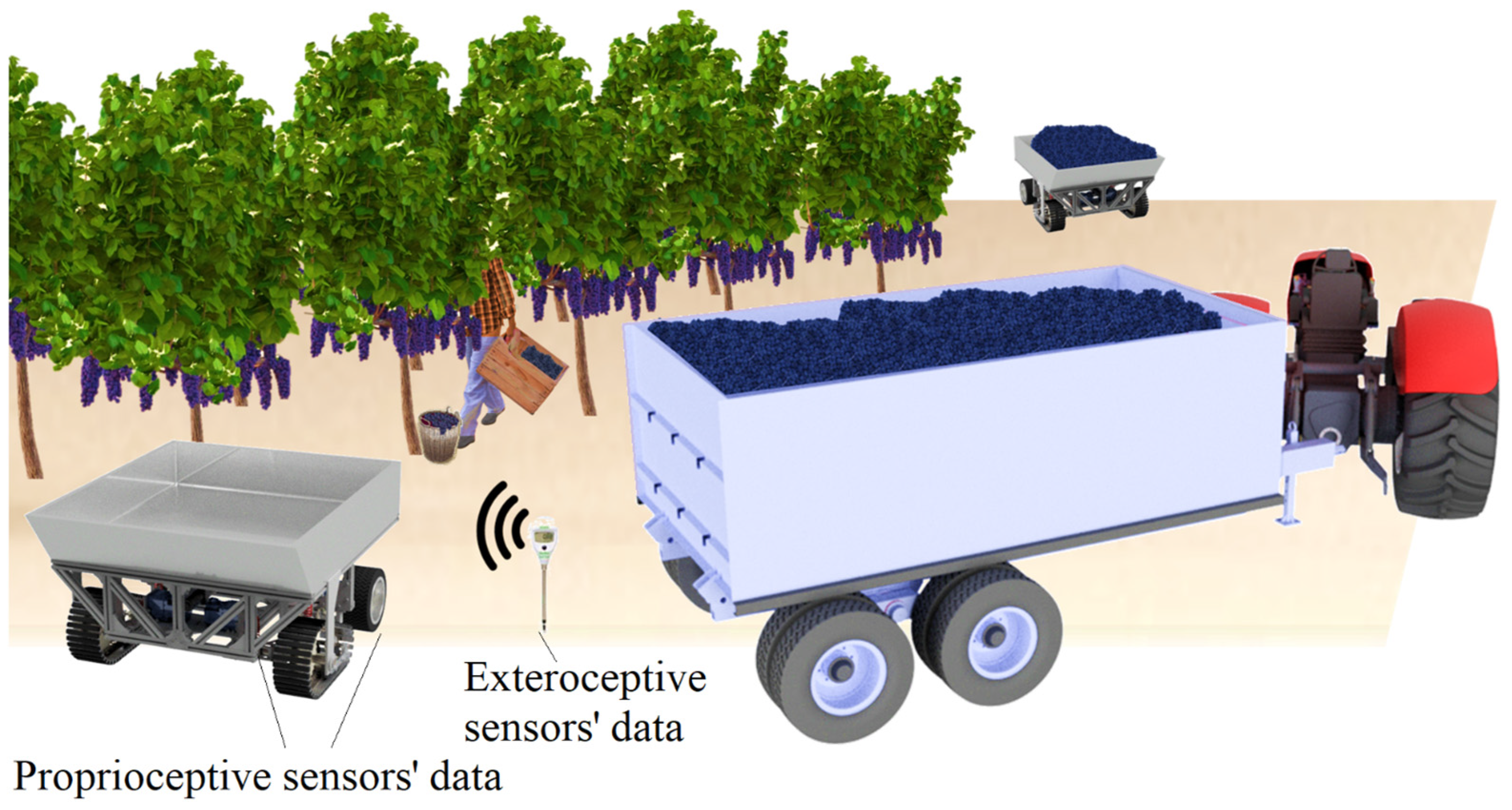

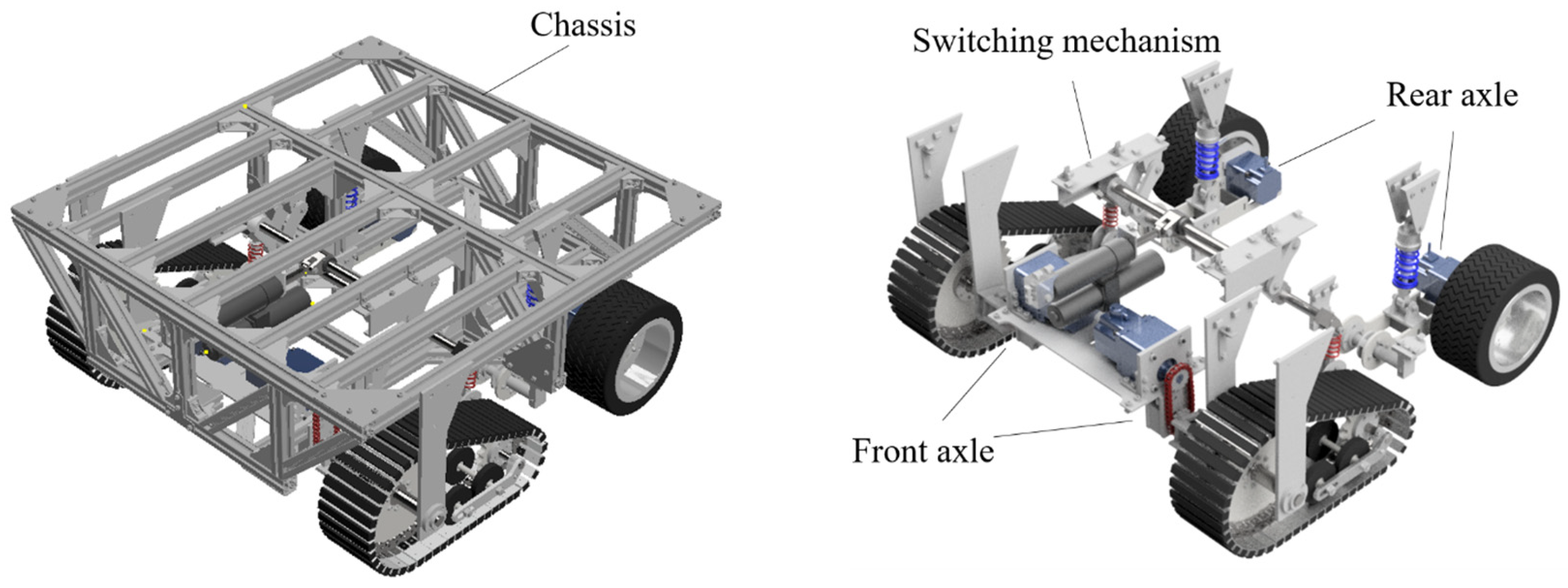



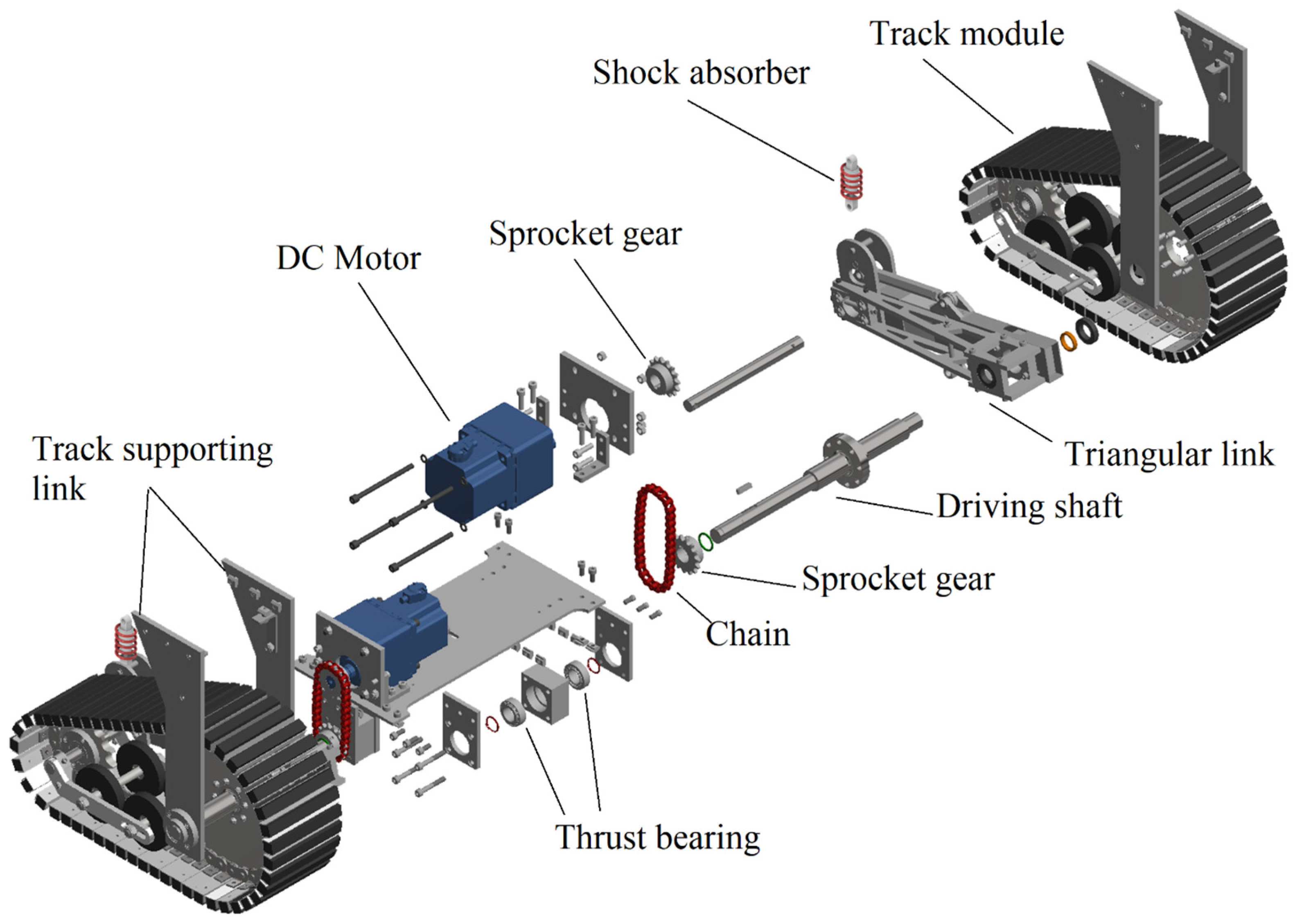
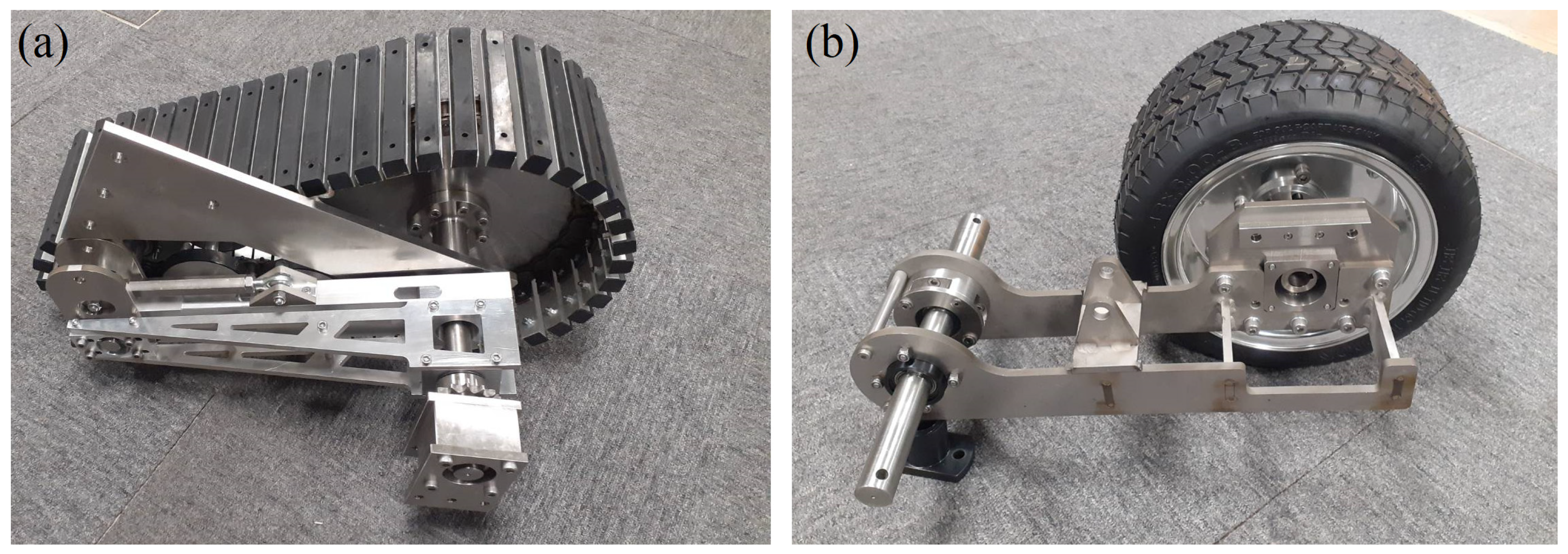


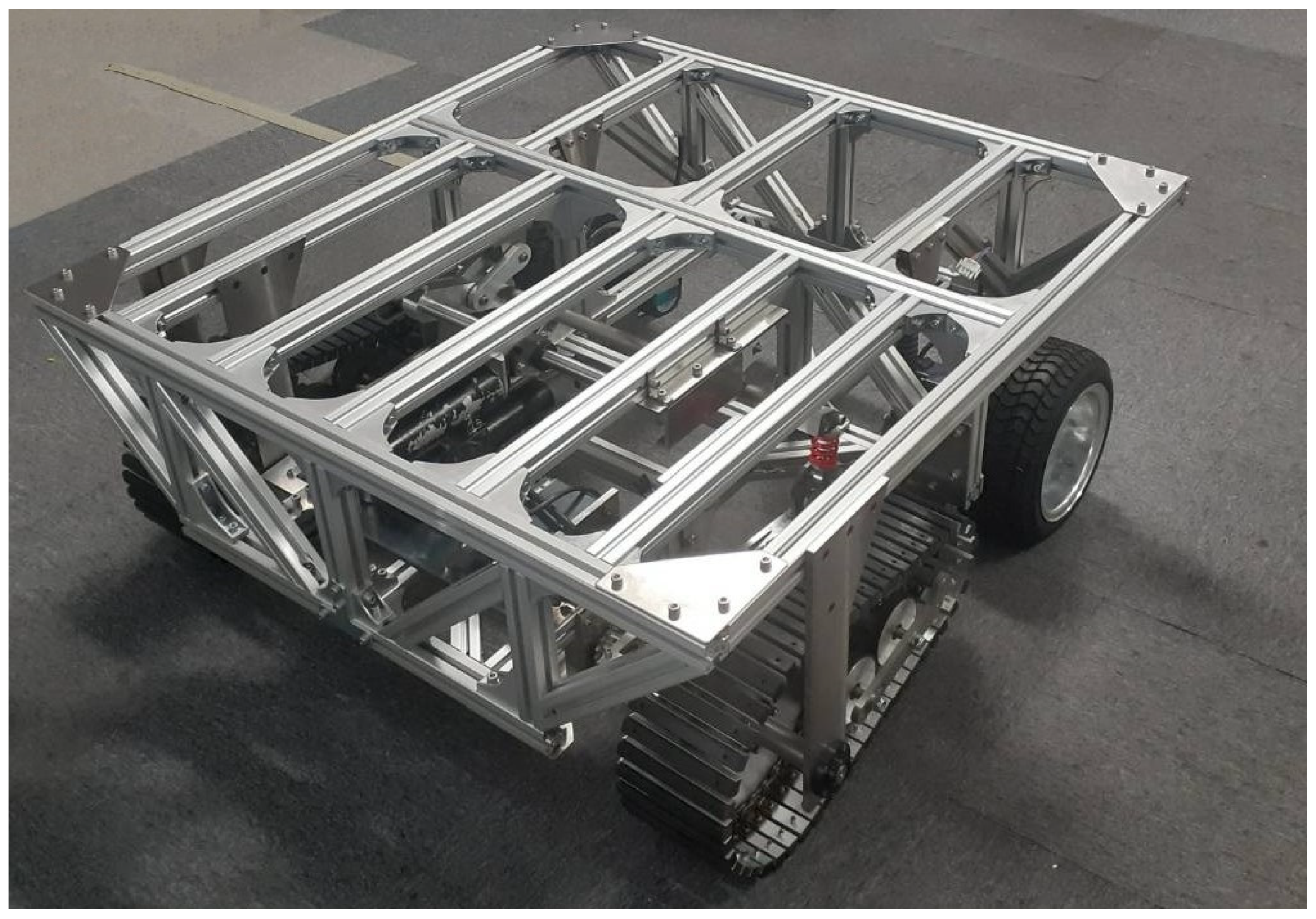

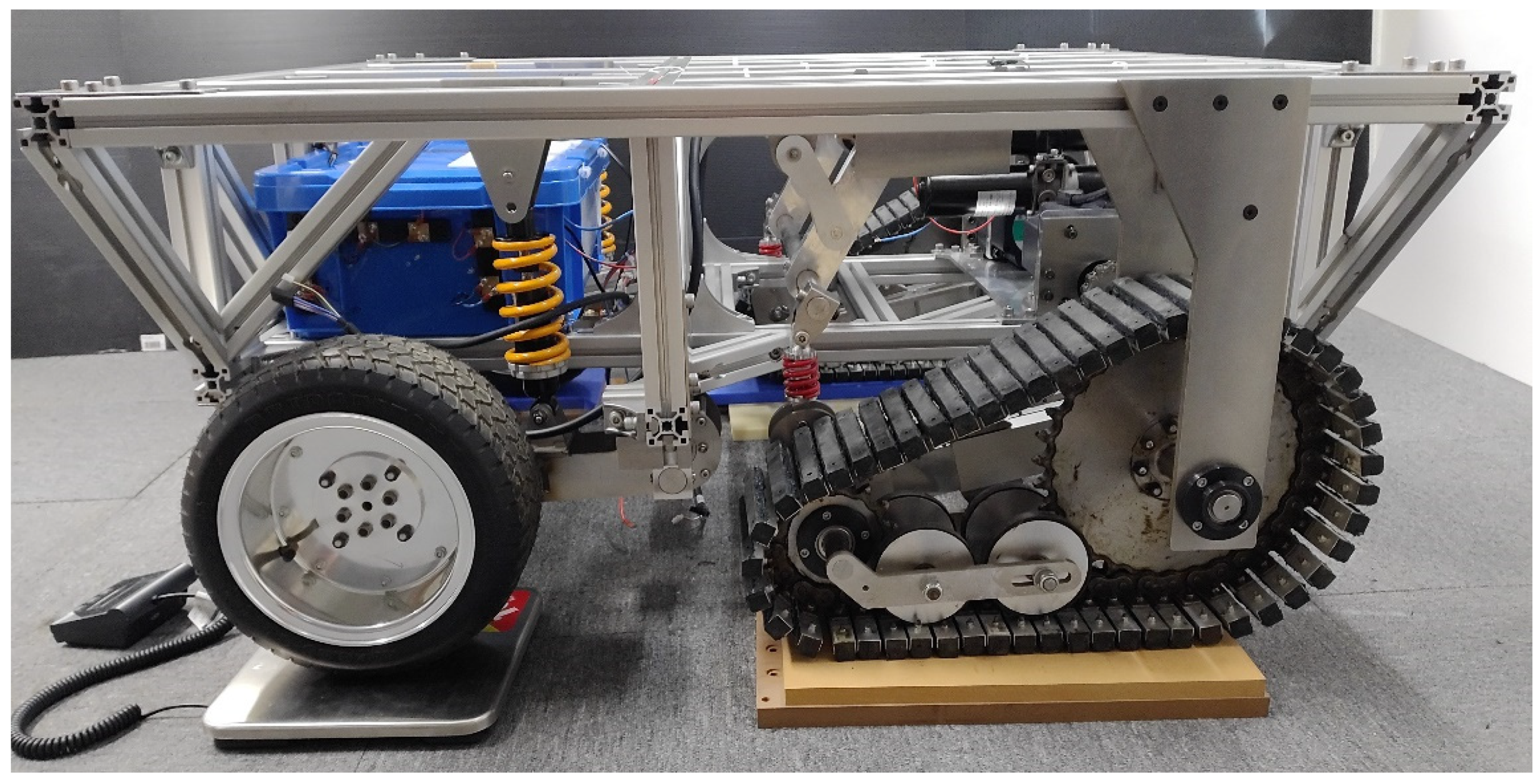
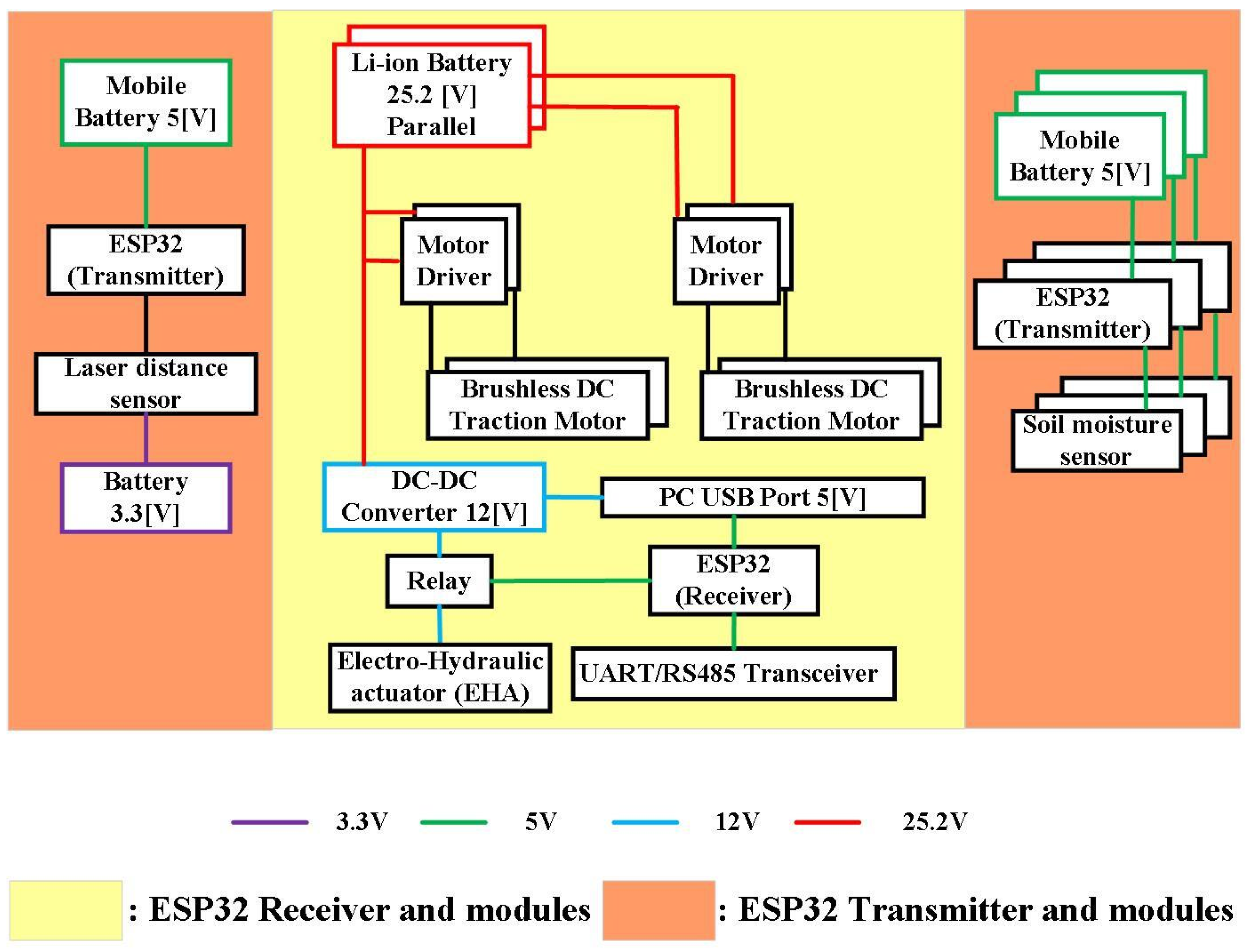

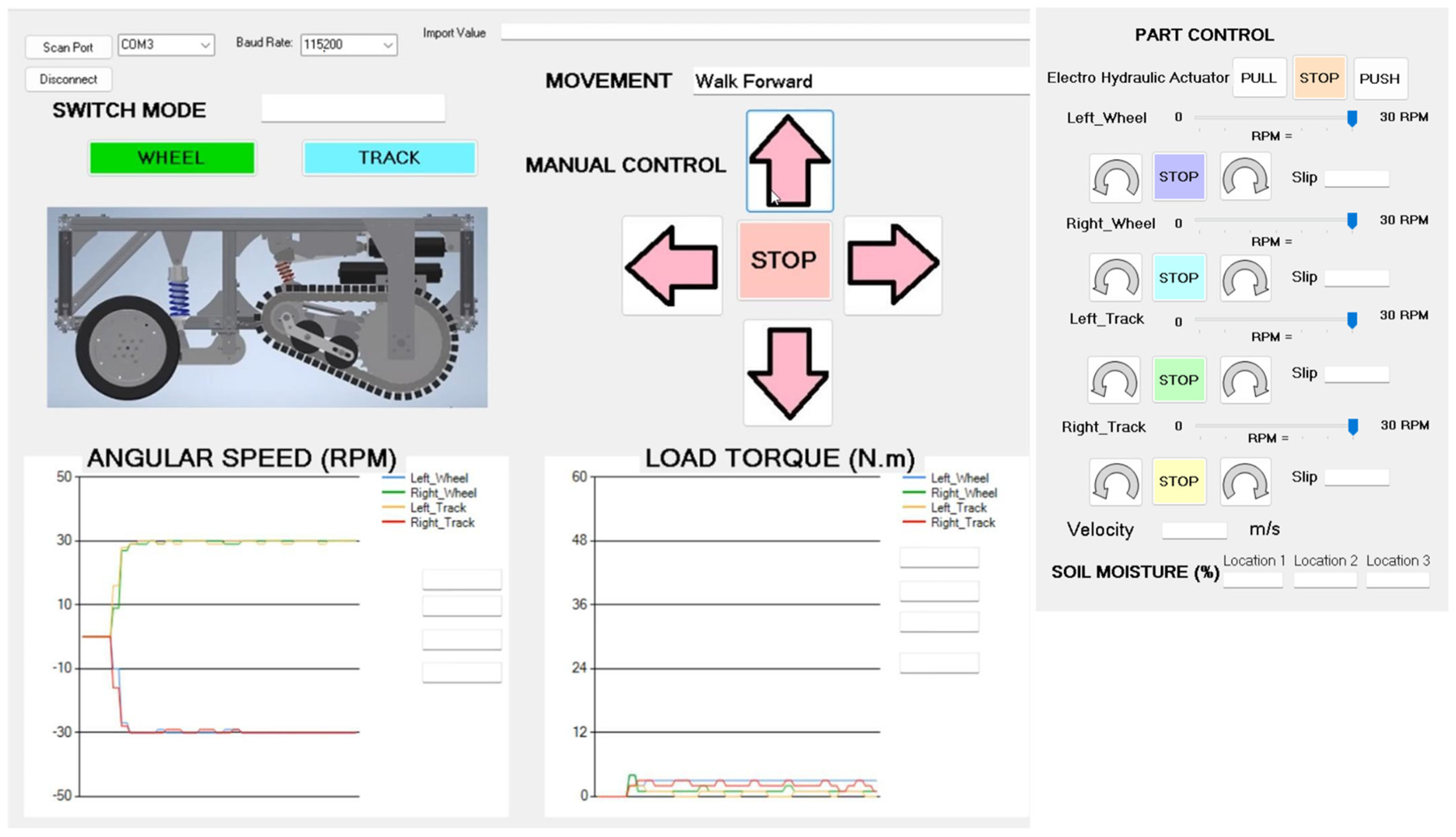

| Component of Gear | Size (mm) |
|---|---|
| Sprocket diameter | 330 |
| Idler diameter | 175 |
| Track width | 160 |
| Wheel diameter | 300 |
| Wheel width | 150 |
| Vehicle Characteristics | Specification |
|---|---|
| Mass | 237.5 kg |
| Size | 1230 mm × 1260 mm × 540 mm |
| Max velocity | 0.5 m/s |
| Battery | Li-ion 25.2 V 27 Ah ×2, mobile battery 5 V |
| EHA | MMP3 12 V, 5800 N |
| Motors | DCM 200 W ×2, DCM 100 W ×2 |
Disclaimer/Publisher’s Note: The statements, opinions and data contained in all publications are solely those of the individual author(s) and contributor(s) and not of MDPI and/or the editor(s). MDPI and/or the editor(s) disclaim responsibility for any injury to people or property resulting from any ideas, methods, instructions or products referred to in the content. |
© 2023 by the authors. Licensee MDPI, Basel, Switzerland. This article is an open access article distributed under the terms and conditions of the Creative Commons Attribution (CC BY) license (https://creativecommons.org/licenses/by/4.0/).
Share and Cite
Kamon, S.; di Maria, E.; Giannoccaro, N.I.; Ishii, K. A New Reconfigurable Agricultural Vehicle Controlled by a User Graphical Interface: Mechanical and Electronic Aspects. Machines 2023, 11, 795. https://doi.org/10.3390/machines11080795
Kamon S, di Maria E, Giannoccaro NI, Ishii K. A New Reconfigurable Agricultural Vehicle Controlled by a User Graphical Interface: Mechanical and Electronic Aspects. Machines. 2023; 11(8):795. https://doi.org/10.3390/machines11080795
Chicago/Turabian StyleKamon, Supaphon, Enrico di Maria, Nicola Ivan Giannoccaro, and Kazuo Ishii. 2023. "A New Reconfigurable Agricultural Vehicle Controlled by a User Graphical Interface: Mechanical and Electronic Aspects" Machines 11, no. 8: 795. https://doi.org/10.3390/machines11080795
APA StyleKamon, S., di Maria, E., Giannoccaro, N. I., & Ishii, K. (2023). A New Reconfigurable Agricultural Vehicle Controlled by a User Graphical Interface: Mechanical and Electronic Aspects. Machines, 11(8), 795. https://doi.org/10.3390/machines11080795







